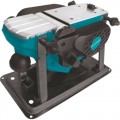Power consumption
The total power consumed by the electric planer during operation. The more powerful the tool, the generally higher its productivity and the better it is suitable for large volumes of work and/or hardwoods. Here, however, it must be taken into account that the effective power (the power supplied by the unit directly to the working tool) is anyway lower than the consumed one, but it is far from always indicated. Therefore, it is quite possible to compare different models with each other precisely in terms of power consumption.
Note that more power means higher electricity consumption, and also, most often, more weight and cost of the tool. Therefore, it does not always make sense to chase the most powerful units. So, for occasional use and small volumes of work, a power of 500-600 W is considered quite sufficient; for regular work on relatively soft wood, 700-800 W is enough, and professional models have a power of more than 1000 W.
Planing width
The width of the strip that the planer processes in one pass. The larger this width, the fewer passes will be needed for surface treatment and the more convenient it will be to work with large workpieces. In most modern electric planers, this figure varies between 80-100 mm.
Note that a larger width requires a more powerful engine and can significantly affect the cost of the tool.
Planing depth
The greatest thickness of the layer of material that the planer can remove in one pass (most often the design provides for depth adjustment). The larger this parameter, the more performant the tool will be and the better it will be suitable for large-scale work. On the other hand, in fact it is rarely necessary to remove a large amount of material at a time, and tools capable of this require powerful (and therefore expensive) motors. Therefore, in most consumer-level models, the planing depth does not exceed 2 mm; more "deeper" units, usually, belong to the professional class.
Grooving depth
The greatest depth of the groove that can be cut into the workpiece with a planer.
Grooves are narrow and long slots used, in particular, for tenoning wooden parts. Some models of electric planers are equipped with special tools that make it easier to cut grooves.
Dust removal
The direction of waste ejection (dust, shavings, etc.) arising from the operation of the electric planer.
— Unilateral. This category includes models that can throw waste only in one direction, without the possibility of change. Most often, the ejection is done to the right — thus, with a classic right-handed grip, the chips will not fly into the user's face. However, left-handers may have problems — there are very few special models for them. And in difficult jobs where an unusual grip may be needed, the inability to change the direction of the ejection can create serious problems. On the other hand, a “one-sided” instrument is simpler and cheaper than a “two-sided” one, other things being equal.
—
Bilateral. Tools from this category have a switch that allows you to choose which direction the chips will be ejected — to the right or to the left. This allows you to optimally set the direction depending on the holding of the planer (right or left hand) and other features of the situation.
In box
—
Dust collector. The presence of a dust collector in the delivery set — a special bag for collecting dust, chips and other waste that occurs during operation. This bag connects directly to the waste chute, so that the waste stays in the dust bin and cleaning up after work becomes much easier. However the dimensions of the tool with the bag attached increase somewhat, and during work it is necessary to monitor its filling and release it in time — otherwise the accumulated chips can jam or even break the planer.
—
Case (bag). The presence in the delivery set of a special case — a suitcase for storing and carrying a tool, which also provides some degree of protection. Using a case for such purposes is much more convenient than various "non-native" packages: it is optimally adapted to a specific planer model, in addition, it often has specialized compartments for additional accessories. There are also rag bags, lighter, but at the same time less protective.

